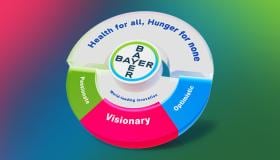Gender Sensitivity

Gender is fundamental to many people’s identities – and it is essential to recognize and affirm everyone’s gender identity and expression, rather than imposing one on them. It’s possible to make errors or reinforce normative gender values even when you act with good intentions – this is why we have developed these recommendations to ensure you can implement gender-inclusive language that respects, includes and empowers your colleagues and audience.
To sustain and grow our business around the globe, we require different business perspectives and the valuable input of a variety of people. This leads to Bayer being a diverse and inclusive organization. This is part of our long-term strategy that fits with our brand’s personality and overarching vision. (For further details, please visit our global website www.bayer.com) To put this into practice in our communications, below we give suggestions on embedding aspects of diversity and inclusion in what we say and write.
Gender sensitivity
Using gender-inclusive language means speaking and writing in a way that does not discriminate against a particular sex, social gender or gender identity, and does not perpetuate gender stereotypes.
According to the United Nations (UN), gender in English has a specific meaning, and there are differences between
“grammatical gender” (masculine/feminine/neuter),
“gender as a social construct” (referring to the roles, behaviors, activities and attributes that a given society at a certain time considers appropriate for men or women) and
“sex” as a biological characteristic of living beings (male/female/others)
From a pure linguistic point of view, gender is the aspect of inclusion that becomes an issue most often. Language isn’t purely abstract – it has real effects on people’s perceptions, and ultimately on safety, diversity and inclusion, especially for women and LGBTQ+ people.
Although our Corporate Language, American English, has very few grammatical gender markers, we have compiled some practical tips to enable gender-sensitive language:
- When addressing a woman on a formal basis, please use “Ms.” rather than “Mrs.” as the former can refer to any woman regardless of her marital status.
- The gender-neutral honorific “Mx.” can be used to address non-binary people or those who do not wish to implicate a gender in their title.
- We recommend using gender-neutral expressions, e.g. ‘flight attendant’ instead of ‘steward/stewardess’. If there is no gender-neutral expression available, be accurate to your subject.
- Also be aware of words with “man-”/“-man” as a component. Seek neutral equivalents to these, e.g. ‘spokesperson’ instead of ‘spokesman’, ‘humankind / humanity’ instead of ‘mankind’.
- Try to avoid using gender-marked pronouns and possessives (like he/she, her/his, himself/herself) when referring to general concepts, as opposed to specific people. See the following examples:
A staff member in Antarctica earns less than he would in New York.
lf a complainant is not satisfied with the board’s decision, he can ask for a rehearing.
A substitute judge must certify that he has familiarized himself with the record of the proceedings.
A staff member in Antarctica earns less than one in New York.
A complainant who is not satisfied with the board's decision can ask for a rehearing.
Substitute judge must certify that they have familiarized themselves with the record of the proceedings.
All employees should feel safe, equal and included at work. It is up to everyone to help foster an organizational culture built on inclusion and acceptance.
One of the easiest ways to advocate for transgender and gender-non-conforming employees and business partners is by respecting their pronouns. Referring to people by the pronouns they identify with is basic to human dignity; it is the first step to demonstrating that they are seen, valued and empowered.
There are many ways people can be respectful of pronouns:
- Don’t assume: If you aren’t sure of someone’s pronouns, you can ask or use gender neutral language such as they/them.
- Share first: Introduce yourself in conjunction with your pronouns, allowing others to follow suit and encourage everyone to share their pronouns in on open and unassuming manner.
- Don’t gate-keep: Pronouns are tied to an individual’s identity and are based on many factors. Simply respect an individual’s pronoun usage as communicated.
If you have any further questions about this or any other section of Bayer ldentity Net, please contact:
Email Signature
Help your colleagues address you the right way, and instill a culture of openness and inclusion, by ‘personalizing’ your email signature and/or how you sign off your emails by putting “Ms.”, “Mr.” or “Mx.” in front of your given name, and/or adding your personal pronouns (he/him/his, she/her/hers, they/them.their).

E-mail footers are used as signatures tor all e-mails and provide binding information about the sender and the company.





